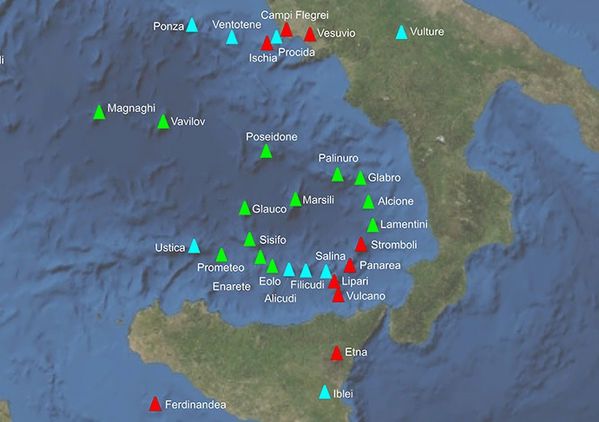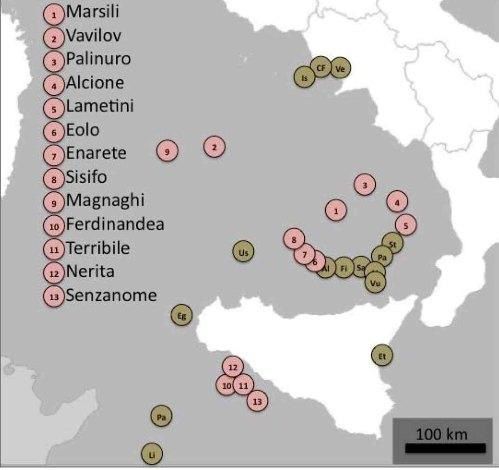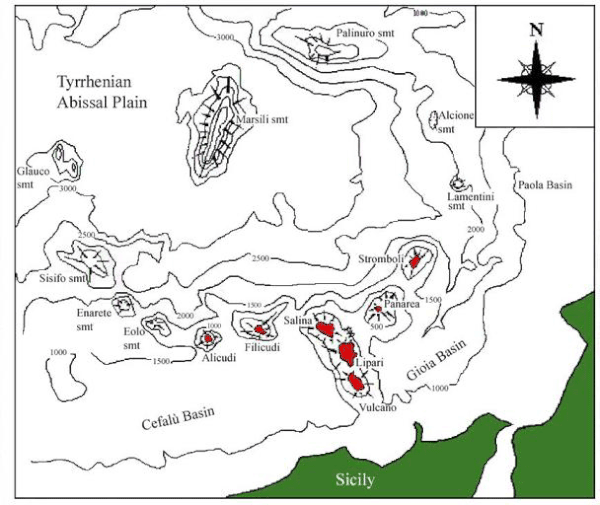Actualité volcanique, Articles de fond sur étude de volcan, tectonique, récits et photos de voyage
The Tyrrhenian basin forms the deepest part of the Mediterranean Sea , with the Tyrrhenian pit to a depth of 3,800 meters. It was caused by a geological process involving African and Eurasian tectonic plates , which began there 10 million years and is contemporary of the formation of the Apennine Mountains .
 Volcanism of the Tirreno Sea (green)
- Volcanoes of the Aeolian arc (red) - Doc. amicidelleterra
Volcanism of the Tirreno Sea (green)
- Volcanoes of the Aeolian arc (red) - Doc. amicidelleterra
Besides the Marsili submarine volcano , other major volcanoes emerge from the central Tyrrhenian plain : the Vavilov , the Magnaghi and many lesser known , including the Palinuro, the Glaucus ,
the Eolo, the Sisyphus , and the Enarete .
Vavilov , Marsili and Magnaghi were discovered in 1950 and
named after the geologists have revealed.
 The submarine volcanoes of the Tirreno Sea ( 1-9 ) and the Sicily Channel
( 10-13 ) - Doc. Protezione Civile - Rischio vulcanico / Volcani Sottomarini
.
The submarine volcanoes of the Tirreno Sea ( 1-9 ) and the Sicily Channel
( 10-13 ) - Doc. Protezione Civile - Rischio vulcanico / Volcani Sottomarini
.
The
Vavilov emerges from the seabed at 3,600 meters and rises until it reaches 684 meters below the sea level. This large building, 30 km x 15 km and 350-400
km3 , can be divided into two parts , according to four dives of the submersible Cyana :
- From its base at 1500 m depth , it consists of thick layers of basaltic
flows.
- Above 1500m depth , smaller flows
emitted by the central volcano, and others through vents aligned NS . Lavas forming the
upper parts are dated from 100,000 to 400,000 years.
Other observations suggest a phase of subaerial terminal
construction, followed by a subsidence of the basin to more than 500 m. depth in the Quaternary.
Vavilov lavas are very close to OIB - Oceanic Island Basalts . Vavilov appears as an independent
structure of the oceanic crust that supports , and does not represent a dorsal-related oceanic accretion.
The Palinuro seamount emerges from nearly 3,000 m depth up to
73 m. under the sea surface, on a fault system oriented EO . It is topped by a shoe-horse caldera. Lavas of the top are dated from the
Pleistocene. Petrochemicals is roughly
identical to that of the Aeolian arc , and interpreted as generated by the subduction of the eastern Mediterranean under the Calabrian arc .
A layer of marine ash , radiocarbon dated to 9,990 years ago , is similar chemically and stratigraphically to two other layers of ash on land south of Italy, and correlated to the activity of
Palinuro seamount ( Siani et al . 2004)
 Position on submarine volcanoes of the
Tirreno Sea compared to the Aeolian arc (in red)
Position on submarine volcanoes of the
Tirreno Sea compared to the Aeolian arc (in red)
The submarine volcanoes
Eolo, Enarete and Sisyphus are aligned NW-SE , west of the Aeolian arc and are high of a thousand meters. Eolo is distinguished from others by a flat top.
Alcione volcano and
its twin, the Lametini are located between the alignment Palinuro - Glabro and the Aeolian arc . These volcanoes have a conical shape, and the surrounding fund exceeds one thousand
meters.
Sources:
- Protezione Civile – Rischio vulcanico / Volcani sottomarini - link
- Structural framework of the Tyrrhenian Sea unveiled by seafloor
morphology - Struttura del Mar Tirreno svelata dalla morfologia del fondale - M.P.Marini & F.Gamberi
- Geomagnetism and age study of Tyrhenian seamounts - O.Faggion & al.
Thème Magazine - Hébergé par Overblog


